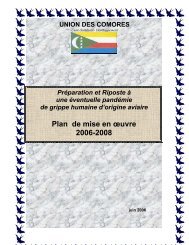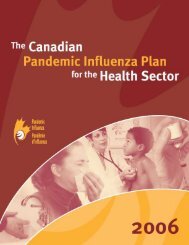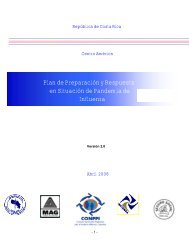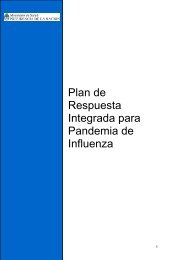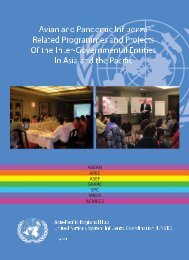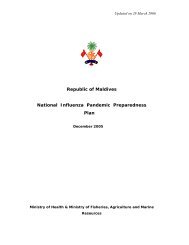GES Simulation Guide v3.pdf - Avian Influenza and the Pandemic ...
GES Simulation Guide v3.pdf - Avian Influenza and the Pandemic ...
GES Simulation Guide v3.pdf - Avian Influenza and the Pandemic ...
Create successful ePaper yourself
Turn your PDF publications into a flip-book with our unique Google optimized e-Paper software.
GOVERNMENT EMERGENCY SIMULATION<br />
ANNEX A.04.02: <strong>GES</strong> IRA (INITIAL RAPID ASSESSMENT) REPORT FORM | Pg 55<br />
GOVERNMENT EMERGENCY SIMULATION<br />
ANNEX A.04.02: <strong>GES</strong> IRA (INITIAL RAPID ASSESSMENT) REPORT FORM | Pg 56<br />
ANNEX A.04.02<br />
<strong>GES</strong> IRA (INITIAL RAPID ASSESSMENT) REPORT FORM<br />
The <strong>GES</strong> IRA Report is used to provide enough basic data for participants to begin preparing <strong>the</strong> response.<br />
Amount of Adaptation<br />
Needed<br />
Adaptation Planning<br />
Schedule<br />
Significant review <strong>and</strong> revision for each <strong>GES</strong> event to ensure<br />
report details correspond to hazard type <strong>and</strong> country-specific<br />
affected areas <strong>and</strong> population groups.<br />
Initial draft should be prepared at least one month in advance<br />
to enable input <strong>and</strong> feedback from <strong>the</strong> Technical Focal Point<br />
who may wish to insert additional details in <strong>the</strong> IRA Report.<br />
The IRA report is a critical document for your exercise; plan to spend a good deal of time <strong>and</strong> effort<br />
preparing it. In essence, <strong>the</strong> IRA report can be considered <strong>the</strong> “trigger” for <strong>the</strong> participants’ response<br />
planning work. It provides <strong>the</strong>m with early damage <strong>and</strong> needs assessment data, enabling <strong>the</strong>m to begin<br />
preparing <strong>the</strong>ir response plans.<br />
The fictional premise behind <strong>the</strong> IRA report is that <strong>the</strong> government has already, at <strong>the</strong> time of <strong>the</strong> Opening<br />
Meeting, received some initial findings from regional government or from emergency service personnel<br />
who are attending <strong>the</strong> scene <strong>and</strong> that information on <strong>the</strong> disaster should soon be forthcoming.<br />
In reality, <strong>the</strong> <strong>GES</strong> IRA report will be h<strong>and</strong>ed out to all participants at <strong>the</strong> end of <strong>the</strong> Opening Meeting.<br />
They will, <strong>the</strong>refore, have “data” with which <strong>the</strong>y can begin planning a response as soon as <strong>the</strong>y return to<br />
<strong>the</strong>ir offices.<br />
BEST PRACTICES<br />
Revise <strong>the</strong> IRA report format to fit your needs. Bear in mind that in developing your IRA data, a delicate<br />
balance with regard to detail is needed. Try to include enough to enable participants to begin <strong>the</strong>ir<br />
response planning – but not so much that <strong>the</strong>y become lost in data at <strong>the</strong> start of <strong>the</strong> exercise: more data<br />
can always be forthcoming in later reports as needed.<br />
Given your chosen hazard type <strong>and</strong> affected areas, try to imagine what an IRA team – i.e. two or three<br />
emergency responders or members of <strong>the</strong> local town council/local government service who have observed<br />
<strong>the</strong> affected areas, talked to people <strong>and</strong> ga<strong>the</strong>red as much information as a small number of people<br />
are capable of doing <strong>and</strong> are reporting back to <strong>the</strong>ir supervisors. Then develop your data, using <strong>the</strong><br />
categories of most use to your exercise.<br />
A blank IRA Report form is provided on <strong>the</strong> next page. Use whichever sections are relevant to your <strong>GES</strong><br />
event.<br />
Samples of IRA Reports used in previous <strong>GES</strong> events can be found in <strong>the</strong> “Documents from<br />
Previous <strong>GES</strong> Events” folder.<br />
<strong>GES</strong><br />
Initial Rapid Assessment (IRA) Report Form<br />
Type of Disaster: ___________________________ Date: _____________ Time: _______________<br />
Region 1 Region 2 Region 3<br />
1 DEMOGRAPHICS: (male/female) (male/female) (male/female)<br />
Population (Est.)<br />
Main livelihoods<br />
# Affected<br />
# Homeless*<br />
# Deaths*<br />
# Missing*<br />
# Injured*<br />
Most vulnerable groups<br />
2 SECURITY & SAFETY:<br />
General situation<br />
O<strong>the</strong>r threats<br />
Police offices (functioning?)<br />
Fire services (functioning?)<br />
3 TRANSPORT / COMMUNICATIONS:<br />
Roads (% blocked)<br />
Major bridges (% destroyed)<br />
Cell-phone networks (functioning?)<br />
4 WATER / SANITATION<br />
Potable water (% of pop. in need)<br />
Water sources<br />
Access to sanitation facilities (% of pop.<br />
in need)<br />
5 SHELTER / HOUSING<br />
# of Damaged houses<br />
# of Destroyed houses<br />
6 FOOD SECURITY & NUTRITION<br />
Availability in markets (Y/N)<br />
Food prices (rising?)<br />
Household access (as % of pop.)<br />
Food insecure (as % of pop.)<br />
7 AGRICULTURE / FISHING<br />
Farml<strong>and</strong> destroyed (% losses)<br />
Dead animals (% losses)<br />
Fishing equipment (% losses)<br />
8 HEALTH<br />
Reported diseases outbreaks<br />
Health infrastructure (% damaged)<br />
Services (% non-functioning)<br />
9 EDUCATION<br />
Schools (% damaged)


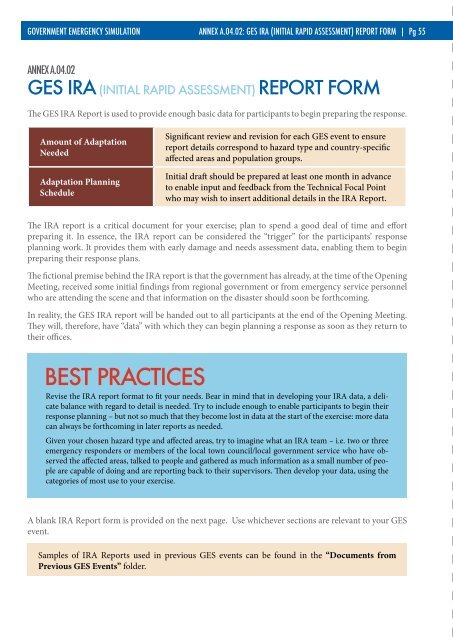
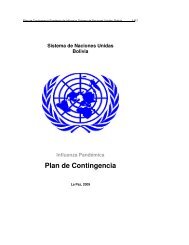
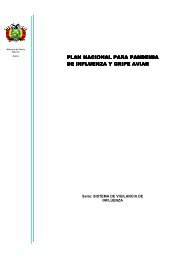
![Tanzania National Plan (January 2007)[1].pdf - Avian Influenza and ...](https://img.yumpu.com/36423433/1/190x245/tanzania-national-plan-january-20071pdf-avian-influenza-and-.jpg?quality=85)
